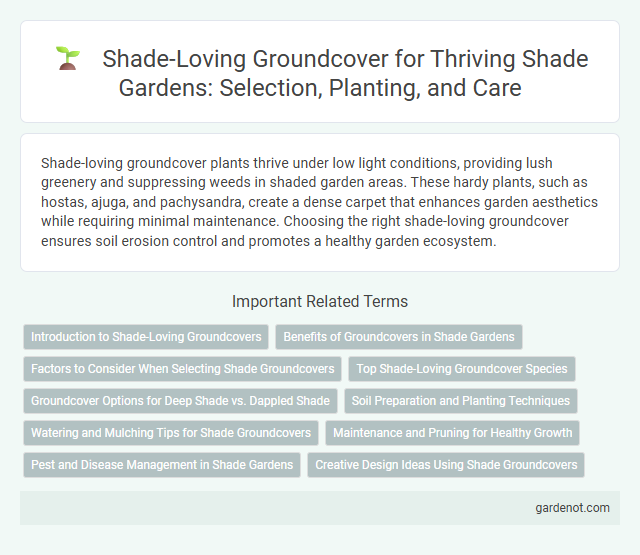Shade-loving groundcover plants thrive under low light conditions, providing lush greenery and suppressing weeds in shaded garden areas. These hardy plants, such as hostas, ajuga, and pachysandra, create a dense carpet that enhances garden aesthetics while requiring minimal maintenance. Choosing the right shade-loving groundcover ensures soil erosion control and promotes a healthy garden ecosystem.
Introduction to Shade-Loving Groundcovers
Shade-loving groundcovers thrive in low-light environments, offering vibrant greenery and texture beneath trees or in shaded garden corners. Popular options like pachysandra, ajuga, and vinca minor provide erosion control and suppress weeds while enhancing soil moisture retention. These plants create a lush, low-maintenance carpet that supports biodiversity and adds year-round visual interest to shade gardens.
Benefits of Groundcovers in Shade Gardens
Shade-loving groundcovers enhance soil moisture retention and suppress weed growth, promoting healthier plant development in shaded areas. These low-maintenance plants improve biodiversity by providing habitat for beneficial insects and reducing soil erosion on slopes or uneven terrain. Groundcovers also contribute to visual appeal by adding texture and color, creating a lush, cohesive look in shade gardens.
Factors to Consider When Selecting Shade Groundcovers
Selecting shade-loving groundcovers requires careful consideration of light tolerance levels, moisture requirements, and soil conditions to ensure optimal growth under limited sunlight. It's important to evaluate the plant's growth habit, such as spreading rate and height, which influence maintenance and landscape aesthetics. Disease resistance and adaptability to local climate zones further determine the long-term success and sustainability of shade groundcovers in garden settings.
Top Shade-Loving Groundcover Species
Top shade-loving groundcover species include Pachysandra terminalis, Vinca minor, and Lamium maculatum, all thriving in low-light environments. Pachysandra terminalis offers dense, evergreen coverage, while Vinca minor produces vibrant blue-purple flowers that brighten shaded areas. Lamium maculatum is valued for its variegated foliage and adaptability to various soil types in shaded garden spaces.
Groundcover Options for Deep Shade vs. Dappled Shade
For deep shade, groundcover options like Pachysandra terminalis and Vinca minor thrive due to their tolerance for low light and dense canopy cover. In contrast, dappled shade areas support a wider variety including Lamium maculatum and Epimedium, which can handle intermittent sunlight while preventing soil erosion. Choosing the right shade-loving groundcover enhances garden health by improving soil moisture retention and suppressing weeds.
Soil Preparation and Planting Techniques
For optimal growth of shade-loving groundcovers, soil preparation involves loosening the soil to a depth of at least 12 inches and incorporating organic matter such as compost or leaf mold to improve moisture retention and aeration. Planting techniques prioritize spacing according to species requirements, ensuring adequate air circulation and reducing competition for nutrients in shaded environments. Mulching with shredded bark or pine needles further maintains soil moisture and suppresses weeds, enhancing establishment and growth in shade garden conditions.
Watering and Mulching Tips for Shade Groundcovers
Shade-loving groundcovers require consistently moist, well-drained soil to thrive, so watering should be deep but infrequent to encourage strong root development. Mulching with organic materials like shredded bark or compost helps retain soil moisture, suppress weeds, and regulate soil temperature in shaded areas. Applying a 2-3 inch layer of mulch around shade groundcovers improves plant health and reduces evaporation, minimizing the need for frequent watering.
Maintenance and Pruning for Healthy Growth
Shade-loving groundcovers require minimal maintenance but benefit from regular pruning to promote healthy growth and prevent overcrowding. Removing dead or damaged foliage ensures better air circulation and reduces the risk of disease, contributing to a lush and vibrant shade garden. Consistent monitoring and timely trimming support the plant's vigor and overall aesthetic appeal in low-light environments.
Pest and Disease Management in Shade Gardens
Effective pest and disease management in shade-loving groundcovers relies on selecting resistant plant varieties such as pachysandra, ajuga, and vinca minor, which naturally deter common shade garden pests like slugs and aphids. Maintaining proper soil drainage and avoiding excessive watering reduce fungal diseases such as powdery mildew and root rot, prevalent in low-light, moist environments. Regular monitoring and incorporating beneficial insects like ladybugs can further control pest populations, ensuring healthy and vibrant shade garden foliage.
Creative Design Ideas Using Shade Groundcovers
Shade-loving groundcovers such as hostas, pachysandra, and ajuga add lush textures and vibrant foliage to shaded garden areas, transforming dull spaces into dynamic visual retreats. Incorporating varied leaf shapes, colors, and heights in creative patterns enhances depth and interest while improving soil health and minimizing weeds. Combining these groundcovers with shaded perennial flowers or ferns creates multi-layered garden designs that thrive in low-light conditions.
Shade-loving groundcover Infographic

 gardenot.com
gardenot.com